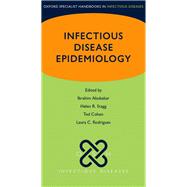
Infectious Disease Epidemiology
by Ibrahim Abubakar; Helen R. Stagg; Ted Cohen-
 eCampus.com Device Compatibility Matrix
eCampus.com Device Compatibility Matrix
Click the device icon to install or view instructions
Rent Textbook
Rent Digital
New Textbook
We're Sorry
Sold Out
Used Textbook
We're Sorry
Sold Out
Summary
Divided into two sections, part one of the book covers a comprehensive list of methods relevant to the study of infectious disease epidemiology, organised in order of increasing complexity, from a general introduction, to subjects such as mathematical modelling and sero-epidemiology. Part two addresses major infectious diseases that are of global significance due to their current burden or their potential for causing morbidity and mortality. The examples have been selected and grouped into chapters based on the route of transmission.
This practical guide will be essential reading for postgraduate students in infectious disease epidemiology, health protection trainees.
Author Biography
Ibrahim Abubakar, Professor of Infectious Disease Epidemiology and Co-Director, Centre for Infectious Disease Epidemiology, University College London, UK,Helen Stagg, Senior Research Associate, Centre for Infectious Disease Epidemiology, University College London, UK,Theodore Cohen, Assistant Professor of Epidemiology, Harvard School of Public Health, Boston, USA,Laura Rodrigues, Professor of Infectious Disease Epidemiology, Faculty of Epidemiology and Population Health, London School of Hygiene and Tropical Medicine, London, UK
Ibrahim Abubakar is a Professor in Infectious Disease Epidemiology. He is director of the University College London (UCL) Centre for Infectious Disease Epidemiology and of the UCL Tuberculosis Centre. He is also head of tuberculosis at Public Health England, London, UK. Prior to his appointment at UCL, he was Professor in Health Protection at the Norwich Medical School, University of East Anglia.
Helen Stagg is a Senior Research Fellow at University College London, where she holds a National Institute for Health Research Postdoctoral Fellowship. Following her laboratory-based PhD in Virology and Immunology from the University of Cambridge, Dr. Stagg shifted disciplines into epidemiology. She has broad interests in communicable diseases across vulnerable and neglected population groups, as well as the interface between the basic sciences and public health.
Ted Cohen is an Associate Professor in the Department of Epidemiology of Microbial Diseases and in the Institute for Social and Policy Studies at Yale University. He uses mathematical modelling and field studies to address questions about the emergence and control of antibiotic resistant pathogens, with a primary research focus on multidrug resistant M. tuberculosis.
Laura C Rodrigues is a Professor of Infectious Disease Epidemiology. Her academic responsibilities include initiating and executing research on the epidemiology of infectious diseases, both in England and internationally, and development of teaching in epidemiological methods, with emphasis on infectious diseases. Laura was born and trained in Brazil, and has been in the LSHTM since 1981. Laura sits in the Scientific Advisory Board of the Novartis Institutes for Vaccines and Global Health in Sienna. She leads the LSHTM initiative for collaborations with Latin America, co leads the Latina America Network (with Pablo Perel), is the LSHTM academic contact for Science without Borders and is a Science without Borders "Professor Visitante Especial" in Universidade Federal da Bahia, a member of the Medicine Galleries Advisory Board of the Science Museum, London and a fellow of the Brazilian Academy of Sciences.
Table of Contents
Part 1
Preface
1. Introduction to infectious disease epidemiology, Ibrahim Abubakar
2. Surveillance, Katie Russell and Mike Catchpole
3. Outbreak investigations, Clarence Tam/Walter Haas
4. Study design, Punam Mangtani
5. Clinical trials, Patrick Phillips and Andrew Nunn
6. Investigating emerging infectious diseases, Ibrahim Abubakarar, Lele Rangaka, and Marc Lipman
7. Investigating nosocomial transmission, Rob Aldridge and Barry Cookson
8. Clinical epidemiology, Adrian SmithandNoel McCarthy
9. Public health microbiology, Helen Staggand, Nigel Field, and Sani Aliyu
10. Molecular and genomic epidemiology, Helen Stagg, Nigel Field, and Duncan MacCannell
11. Sero-epidemiology and analysis of immunological data, Saranya Sridhar and Ibrahim Abubakar
12. Vaccine evaluation: efficacy and adverse events, Laura Rodrigues
13. Basic statistical methods, Laura White
14. Spatial epidemiology, Tom Yates, Frank Tanser, and Alexandre Blake
15. Contact studies, Ken Eames and Charlotte Jackson
16. Transmission-dynamic models of infectious diseases, Ted Cohen and Peter White
17. Economic analysis of interventions against infectious diseases, Mark Jit and Peter White
Part 2
18. Respiratory infections, John Watson and Mary Cooke
19. Faeco oral infections, Paul Hunter and Emma Meader
20. Vector-borne infections, Gloria Taxiera
21. Health-care-associated infections, David Weber, Emily E. Sickbert-Bennett, and William A. Rutala
22. Hepatitis B and C, Sema Mandal, and Koye Balogun
23. Sexually transmitted infections: epidemiology and control, Pam Sonnenberg, and Anne Johnson
24. Transmissible spongiform encephalopathies, Peter Smith
25. Human immunodeficiency virus (HIV) infections, Andrew Boulle, and Leigh Johnson
26. Parasitic infestations, Mauricio Barreto, and Phil Cooper
27. Congenital Infections, Tanvi Sharma, and Lakshmi Ganapathi
An electronic version of this book is available through VitalSource.
This book is viewable on PC, Mac, iPhone, iPad, iPod Touch, and most smartphones.
By purchasing, you will be able to view this book online, as well as download it, for the chosen number of days.
Digital License
You are licensing a digital product for a set duration. Durations are set forth in the product description, with "Lifetime" typically meaning five (5) years of online access and permanent download to a supported device. All licenses are non-transferable.
More details can be found here.
A downloadable version of this book is available through the eCampus Reader or compatible Adobe readers.
Applications are available on iOS, Android, PC, Mac, and Windows Mobile platforms.
Please view the compatibility matrix prior to purchase.

